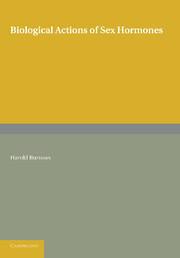Book contents
- Frontmatter
- CONTENTS
- PREFACE
- PART I GONADOTROPHINS
- PART II GONADAL HORMONES
- PART III ANDROGENS
- PART IV OESTROGENS
- CHAPTER XI Oestrogens
- CHAPTER XII The Action of Oestrogen on the Embryonic Gonads. and Miillerian and Wolffian Systems
- CHAPTER XIII The Action of Oestrogen on the Anterior Lobe of the Pituitary, and on the Gonads after their Differentiation
- CHAPTER XIV The Action of Oestrogen on the Accessory Genital Organs after their Differentiation, with a special reference to inguinal hernia
- CHAPTER XV The Action of Oestrogen on the Accessory Genital Organs
- CHAPTER XVI The Action of Oestrogen on the Accessory Genital Organs
- CHAPTER XVII The Effects of Oestrogen on the Mamma
- CHAPTER XVIII Factors in the Causation of Mammary Cancer
- CHAPTER XIX The Effects of Oestrogen on Connective Tissues and Skin
- CHAPTER XX The Actions of Oestrogen on organs other than those considered in earlier chapters
- PART V PROGESTINS
- PART VI SEX HORMONES OF THE ADRENAL CORTEX
- APPENDIX
- REFERENCES
- GLOSSARY
- INDEX
CHAPTER XIV - The Action of Oestrogen on the Accessory Genital Organs after their Differentiation, with a special reference to inguinal hernia
from PART IV - OESTROGENS
Published online by Cambridge University Press: 05 June 2016
- Frontmatter
- CONTENTS
- PREFACE
- PART I GONADOTROPHINS
- PART II GONADAL HORMONES
- PART III ANDROGENS
- PART IV OESTROGENS
- CHAPTER XI Oestrogens
- CHAPTER XII The Action of Oestrogen on the Embryonic Gonads. and Miillerian and Wolffian Systems
- CHAPTER XIII The Action of Oestrogen on the Anterior Lobe of the Pituitary, and on the Gonads after their Differentiation
- CHAPTER XIV The Action of Oestrogen on the Accessory Genital Organs after their Differentiation, with a special reference to inguinal hernia
- CHAPTER XV The Action of Oestrogen on the Accessory Genital Organs
- CHAPTER XVI The Action of Oestrogen on the Accessory Genital Organs
- CHAPTER XVII The Effects of Oestrogen on the Mamma
- CHAPTER XVIII Factors in the Causation of Mammary Cancer
- CHAPTER XIX The Effects of Oestrogen on Connective Tissues and Skin
- CHAPTER XX The Actions of Oestrogen on organs other than those considered in earlier chapters
- PART V PROGESTINS
- PART VI SEX HORMONES OF THE ADRENAL CORTEX
- APPENDIX
- REFERENCES
- GLOSSARY
- INDEX
Summary
External Genitalia
Penis. Clitoris. Scrotum and Perineum.
(i) Before complete development. When considering this subject the period of our inquiry is not limited by the date of birth, for at this time the external generative organs in many species have not attained their permanent form. This is notably the case with mice, rats and rabbits; these animals are born in a very immature state.
Hypospadias. Oestrone when given to the mother shortly before parturition, or to the young soon after birth, may restrict in the male the growth of the scrotum and penis, so that these structures resemble those of the female in character (Lacassagne, 1934b). In the female hypospadias is readily produced. This result has been recorded by Hain (1935 a), Wiesner (1935), Greene & Ivy (1937) and Turner & Burkhardt (1939). It should be explained that normal female rats and mice possess a penis somewhat like that of the male, the urethra in both sexes terminating at the free extremity of the organ. In the condition produced by oestrogens in female rats and mice, and here described as hypospadias, there is a median ventral cleft in the penis so that the urethra opens close to the vagina, and the external genitalia conform to the pattern of those organs in the female of the human and many other species. Hain (1935 a) injected 1 mg. of oestrone into pregnant rats between the 17th and 20th days of gestation. All the female young which survived this treatment had ventral clefts of the urethra. A similar condition could be caused shortly after birth by giving oestrone to the lactating mother, the oestrogen being conveyed to the young in the milk. This result occurred after the administration of 2 mg. of oestrone to the mother during the first 4 days after parturition, or after 2 mg. were given as a single dose on the 3rd postnatal day, or after 3 mg. given during the first 2 days. Hain (1936) found that the same condition could be produced by injecting oestrone directly into the newborn young. Greene & Ivy (1937) obtained similar results in rats by injecting 2 or 3 mg. of oestradiol into the mother before parturition or 0.2 to 0.4 mg. into the newborn females.
- Type
- Chapter
- Information
- Biological Actions of Sex Hormones , pp. 289 - 294Publisher: Cambridge University PressPrint publication year: 2013

